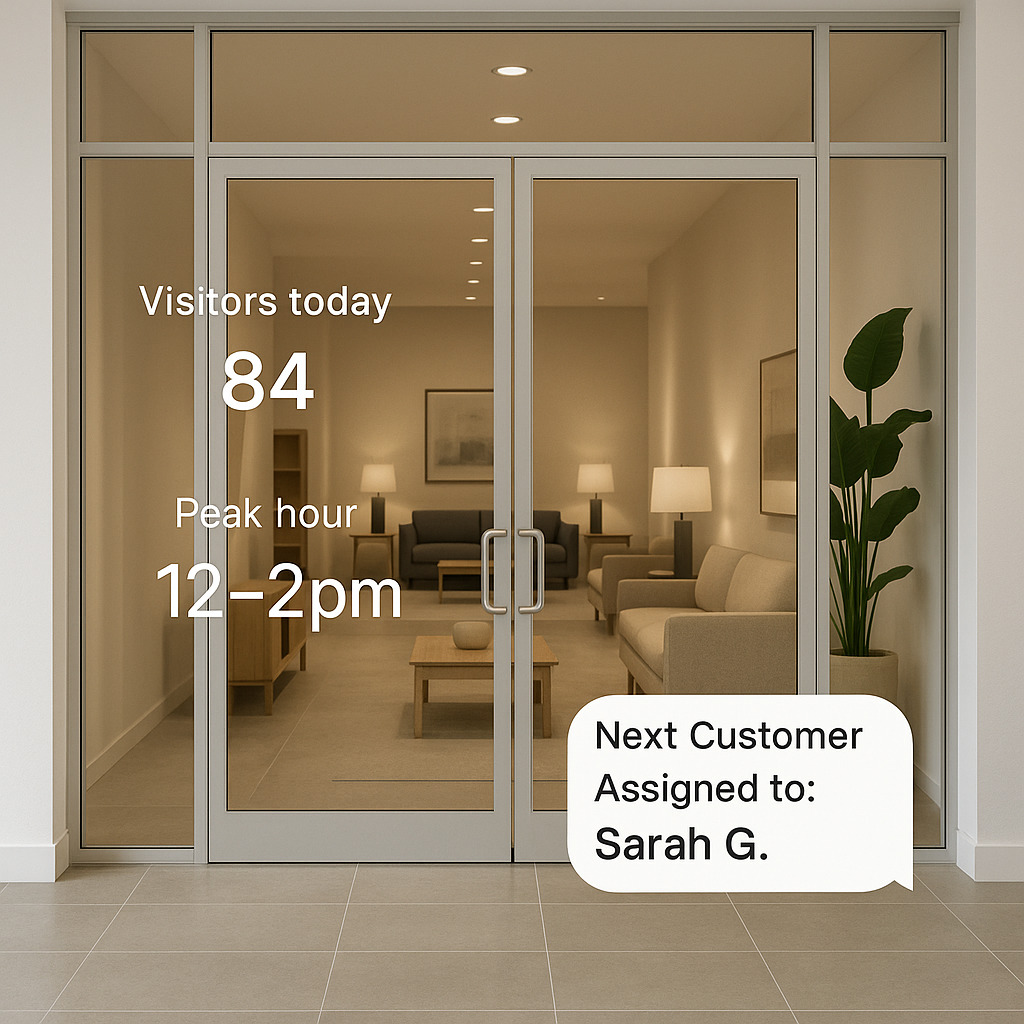In furniture retail, a single missed opportunity can mean hundreds or thousands in lost revenue. People counting shows how many shoppers walk in, how they convert, and where staffing or follow-up can improve outcomes. When done right, it’s not just a “door counter”—it’s the backbone of smarter schedules, higher conversion, and consistent growth.
Why people counting matters in furniture retail
Furniture showrooms sit at the intersection of high ticket value and variable traffic. You may see weekday lulls and weekend spikes—or seasonal bursts around moving season and holidays. Without accurate counts, managers rely on gut feel:
Conversion clarity: Know if a slow week is low traffic or low close rate.
Staffing precision: Place your best closers during peak hours; avoid overstaffing during dips.
Marketing accountability: Tie local ads, events, and promotions to real store traffic and sales lift.
Multi-store comparability: Normalize performance across locations with apples-to-apples data.
TraxSales stands out with a camera-based platform that delivers verifiable accuracy—capturing time-stamped photos of each visitor. Many furniture retailers also love that TraxSales can assign photos to specific salespeople, making coaching and accountability straightforward. And because TraxSales helps you track unsold customers, you can build a stronger clienteling pipeline instead of letting traffic slip away.
Bonus: If you already have security cameras, TraxSales can often use your existing infrastructure to count, streamlining installation and lowering total cost of ownership.
From foot traffic to sales: the three levers you can control
Traffic (T) — how many visitors enter.
Conversion (CR) — the % of visitors who buy.
Average Ticket (ATV) — average spend per order.
While traffic is influenced by marketing and seasonality, CR and ATV are where furniture teams win:
Staff to demand: Match schedule blocks to actual hourly traffic.
Coach with evidence: With photos attached to interactions, managers can debrief customer journeys, not just guess what happened.
Follow up with unsold: If a guest leaves, track “who they spoke with,” “what they looked at,” and why they didn’t purchase. Then set specific callbacks, quotes, and second-visit appointments.
Mini case example (anonymized)
A three-location furniture retailer implemented TraxSales across all stores.
Before: Weekend rushes felt “busy,” but results were uneven. Managers scheduled evenly across the week.
After 45 days: People counting revealed a clear traffic crest from 11am–2pm Sat/Sun and a micro-peak Thurs 5–7pm. The team reallocated senior reps to peaks and created a formal unsold-follow-up workflow using TraxSales assignments.
Result: In the next 60 days, the retailer saw a meaningful conversion uptick and steadier close rates across all three stores. Marketing also used traffic data to shift ad spend toward proven high-traffic windows.
(Results vary by store; this is an example of how process changes—guided by accurate counts—can drive improvement.)
How to choose a people counter (checklist)
Accuracy you can verify: Camera-based counting with time-stamped images for auditing.
Sales accountability tools: Ability to assign visits to salespeople for coaching and pipeline.
Unsold tracking: Capture reason codes, quotes, and follow-up steps.
Peak-hour insights: Hourly/daily traffic patterns for staffing.
Multi-store rollups: Compare conversion, average ticket, and staffing alignment across locations.
Privacy & compliance: Configurable retention and access controls; visitor images used solely for operational analytics.
Fast deployment: Use existing cameras when possible to reduce costs and downtime.
Support & training: Retail-specific onboarding and playbooks for managers.
Calculate ROI: a simple formula furniture retailers use
Incremental Gross Profit = (Traffic × ΔConversion × Average Ticket × Gross Margin)
ROI % = \(Incremental Gross Profit − Cost of Solution\) ÷ Cost of Solution × 100
Example:
Monthly Traffic = 5,000 visitors
Baseline Conversion = 22%
New Conversion = 23% (ΔConversion = 1 percentage point)
Average Ticket (ATV) = $1,250
Gross Margin = 45%
TraxSales cost (example) = $99
Incremental Gross Profit
= 5,000 × 0.01 × $1,250 × 0.45
= $28,125 (gross profit)
If your monthly all-in cost is, say, $2,000, then:
ROI % = [($28,125 − $2,000) ÷ $2,000] × 100 ≈ 1,306%
Even a 1-point conversion improvement can be material in furniture. People counting provides the visibility to find—and sustain—that point.
Common mistakes that hold furniture stores back
Treating people counting like a vanity metric. Counting without conversion and staffing action is just a chart on the wall.
Measuring traffic, not outcomes. Tie visits to salespeople and track unsold workflows so insights become revenue.
Ignoring micro-peaks. The difference between 12–2pm and 2–4pm can be real. Schedule accordingly.
No auditing. If you can’t verify accuracy, you can’t trust the data—or the decisions based on it.
One-and-done coaching. Use image-verified encounters for ongoing skill development, not just monthly recaps.
Getting started with TraxSales
TraxSales helps furniture retailers see every opportunity and coach every interaction. With verifiable, camera-based accuracy, assignments to salespeople, unsold tracking, and the ability to leverage existing cameras, you get the operational truth needed to staff better, lift conversion, and grow sales—store by store.
Book a demo: https://letsmeet.io/traxsales/people-counting-software
Read customer testimonials: https://traxsales.com/retail-store-traffic-counter-testimonials
Alt text: “Furniture store entrance with people counting overlay and staff assign


